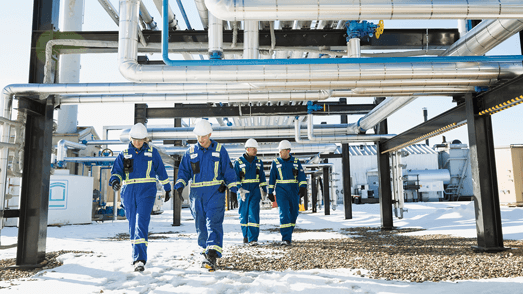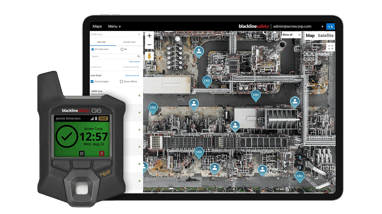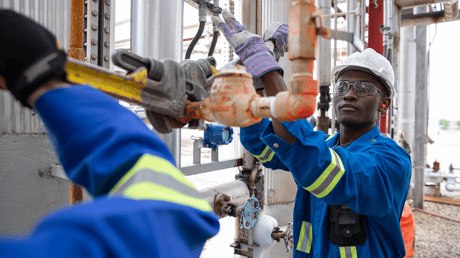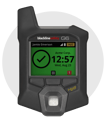Chad Grady is a Business Development Director at Blackline Safety. In this role, he builds strategic plans guided by his ability to maintain relationships with clients, partners, and stakeholders to close deals and exceed revenue targets. With 20 years of experience in sales roles within safety, he has a deep understanding of the sales process and is adept at developing successful outcomes. Chad has a strong track record of identifying new business opportunities by showcasing innovative solutions to meet their needs. He has an educational background in Business Administration from the University of Texas at Permian Basin.
Beyond Compliance: The Power of Lifesaving Single-Gas Detection
Chad Grady, Business Development Director
March 01, 2024

In large and complex industrial settings like refineries, oil and gas facilities, and petrochemical plants, employee and contractor safety is the number one priority. Amidst the myriad of risks prevalent in these workplaces, exposure to hydrogen sulfide (H2S)—at any level—emerges as a top concern.
Historically, regulatory compliance has been the impetus behind the implementation of gas detection systems, like traditional beep-and-flash detectors, to protect workers from exposure to gases like H2S. However, leading companies understand that old monitoring equipment just doesn’t measure up anymore when their people’s lives are on the line every day.
Cloud-connected single-gas detectors have emerged as critical tools to protect at-risk workers while fostering a stronger safety-focused culture. Not only do they ensure adherence to regulations, but they boost overall workplace safety and efficiency, too. That’s due to their sophisticated gas sensors, real-time notifications for fast incident response, and essential analytics to help companies get in front of hazards and save lives.
In industries where hazardous gases pose potential risks to human health and safety, the choice of gas detection devices can be a critical factor in preventing accidents and saving lives. |
Rising Risks From H2S Exposure
Hydrogen sulfide, naturally occurring in crude oil and prevalent in sour gas fields, poses severe health risks to workers. One of the biggest risks of encountering H2S at high concentrations is the “knockdown” effect, where workers are overcome by the gas concentration and collapse due to exposure—this can lead to death in some cases. However, even lower levels of H2S exposure may cause rapid loss of consciousness and difficulty breathing without warning. This underscores the criticality of timely detection and response to mitigate work-related incidents.
Despite regulatory guidelines from organizations like the US Occupational Safety and Health Administration (OSHA), the number of workers facing death, injury, and illness due to H2S exposure continues to rise. There is an urgent need for more robust safety measures to address the limitations of the current ones.
|
DID YOU KNOW? |
|
Connected gas detector averts tragedy from H2S exposure Read the real-life incident of how a colleague’s cloud-connected gas detection device saved a worker’s life at a pipeline terminal in rural Texas. Additional fatalities were prevented thanks to the early identification of the presence of H2S and the evacuation of the rest of the team members. |
Demand More: Limitations of Traditional Gas Detection Devices
Traditional gas detectors, characterized by their beep-and-flash alerts, have long been the cornerstone of gas detection compliance, alerting workers to the presence of harmful gases. However, these devices fall short of fully protecting workers, with not even a panic button to seek help when needed. Here are a few more reasons why they fail to meet best practices anymore:
Limited communication: Traditional devices operate in isolation, with little to no communication capabilities. In larger industrial settings, this lack of connectivity can result in delayed response times and hinder the coordination of emergency procedures.
Limited awareness: Traditional beep and flash devices rely solely on their local alarms to notify nearby individuals. In large or noisy environments, there is a risk of individuals not hearing the alarm or being unaware of the danger, leading to delayed reactions--you don’t know what you don’t know.
Lone workers more vulnerable: If someone is working alone and becomes unconscious due to H2S exposure, traditional devices cannot alert others to the need for help.
Delays in data retrieval: Collecting and analyzing data from traditional devices can be a manual and time-consuming process, especially as they need to be physically docked before the data can be retrieved. This can delay the ability to identify trends or potential issues before they escalate, impeding the implementation of proactive safety measures.
Finite lifespan: Disposable beep and flash detectors have a life span of two years, contributing to a higher cost of ownership.
High loss rate: Up to 20% of disposable gas detectors are lost each year as they do not have integrated location technology.
These limitations underscore the need for a more advanced approach to gas detection.
|
DID YOU KNOW? |
The Added Value of Connectivity and Analytics
The introduction of connected single-gas detectors, like Blackline Safety's G6, heralds a new era in gas detection technology.
These devices are specifically equipped with advanced features to address the shortcomings of traditional models to deliver:
Faster and safer incident response: Real-time alerts, with up-to-date location and safety status information, mean monitoring personnel can take immediate and informed action in the event of an incident.
Emergency SOS: For lone workers, especially those operating in remote areas or deserted sites, the ability to manually trigger an emergency SOS during critical situations can be a literal lifeline.
Improved safety and compliance: Automated analytics provide insights to improve worker safety and manage compliance—with single-source data all in one platform. No more waiting around to understand usage, calibration and bump testing status. Take proactive actions to prevent incidents in the first place.
Boosted operational efficiency: Integrated location information and a cloud-based platform mean fewer lost devices, a reduced IT burden and simplified fleet management. The result is a lower overall cost of ownership.
Unmatched device life: Designed to be long-lasting, durable, and futureproofed with no need to redeploy a device fleet every two years, devices like G6 can free up workers and IT teams.
 It’s clear that investing in connected safety is the right thing to do. Not only does it guarantee your people have access to the fastest response time possible, but you also get detailed insights to report on ongoing exposure, arm your team with data to get in front of risks before they become acute, and reach that always sought-after 100% compliance goal.
It’s clear that investing in connected safety is the right thing to do. Not only does it guarantee your people have access to the fastest response time possible, but you also get detailed insights to report on ongoing exposure, arm your team with data to get in front of risks before they become acute, and reach that always sought-after 100% compliance goal.
Battling worker complacency and ensuring safety is always top-of-mind, and is one of the hardest parts of a safety manager’s role. These devices can help, while still respecting worker rights and expertise.
At the end of the day, protecting your peoples’ well-being is the top priority. Each of your workers is someone’s loved one—a parent, a spouse, a sibling, a best friend— so ensuring their safe return home each day is paramount. Every second counts in situations involving gas exposure, such as H2S. Knowing when and where a worker is exposed, in real-time, is critical to saving their life. Don’t wait until it is too late to discover the shortcomings of your old gas detection devices.
The Lifesaving Tech to Move Beyond Compliance is Here
With greater monitoring and protection against H2S exposure risks, it is possible to reduce the number of work-related incidents and improve overall worker safety. Protecting workers from potential hazards will only continue to grow in legislative strength as the energy industry moves into new territories for extracting oil, gas and coal, and moves into other areas of energy production such as anaerobic digestion and biofuels, both of which carry high risks of H2S exposure.
While traditional beep-and-flash gas detectors have played a crucial role in workplace safety, the advent of connected single gas detectors represents a significant advancement in the field of gas detection technology.
The ability to manually trigger an emergency SOS, transmit real-time data, and leverage cloud-based platforms for enhanced analytics and management makes connected detectors a top choice for industries prioritizing safety. By embracing connected safety solutions, organizations can not only meet regulatory requirements but also save lives, prevent accidents and foster a culture of safety excellence.

|
“G6 filled a gap in our safety program, as we needed an easy-to-use and maintain device more suited to temporary or short-time visitors on site. This freed up our Blackline G7 lone worker and multi-gas detectors for personnel in more hazard-prone situations. With Blackline Safety, we get one partner and one platform to manage all our safety needs.” –Leading US Energy Company and Blackline Customer |
Get In Touch
Let’s start a discussion about your safety challenges and needs.
Related Blog Posts
When Seconds Matter: Protecting Emergency Responders and the Public from Radiation
March 28, 2025
Picture the scene: a firefighter races to a dumpsite unaware that improperly disposed of radioactive materials are present. The Geiger counter at the...
Why Cloud-Connected Safety Solutions Are a Game-Changer
July 10, 2024
Cloud vs. On-Premises: What’s Right for Your Workers? What does it mean to connect safety devices through on-premises docking stations or gateways...
Cool Under Fire: How Blackline Safety is Transforming Emergency Response
June 26, 2024
Real-time data and advanced gas monitoring technology empower fire and hazmat teams to tackle the toughest emergencies with confidence As dangerous...




